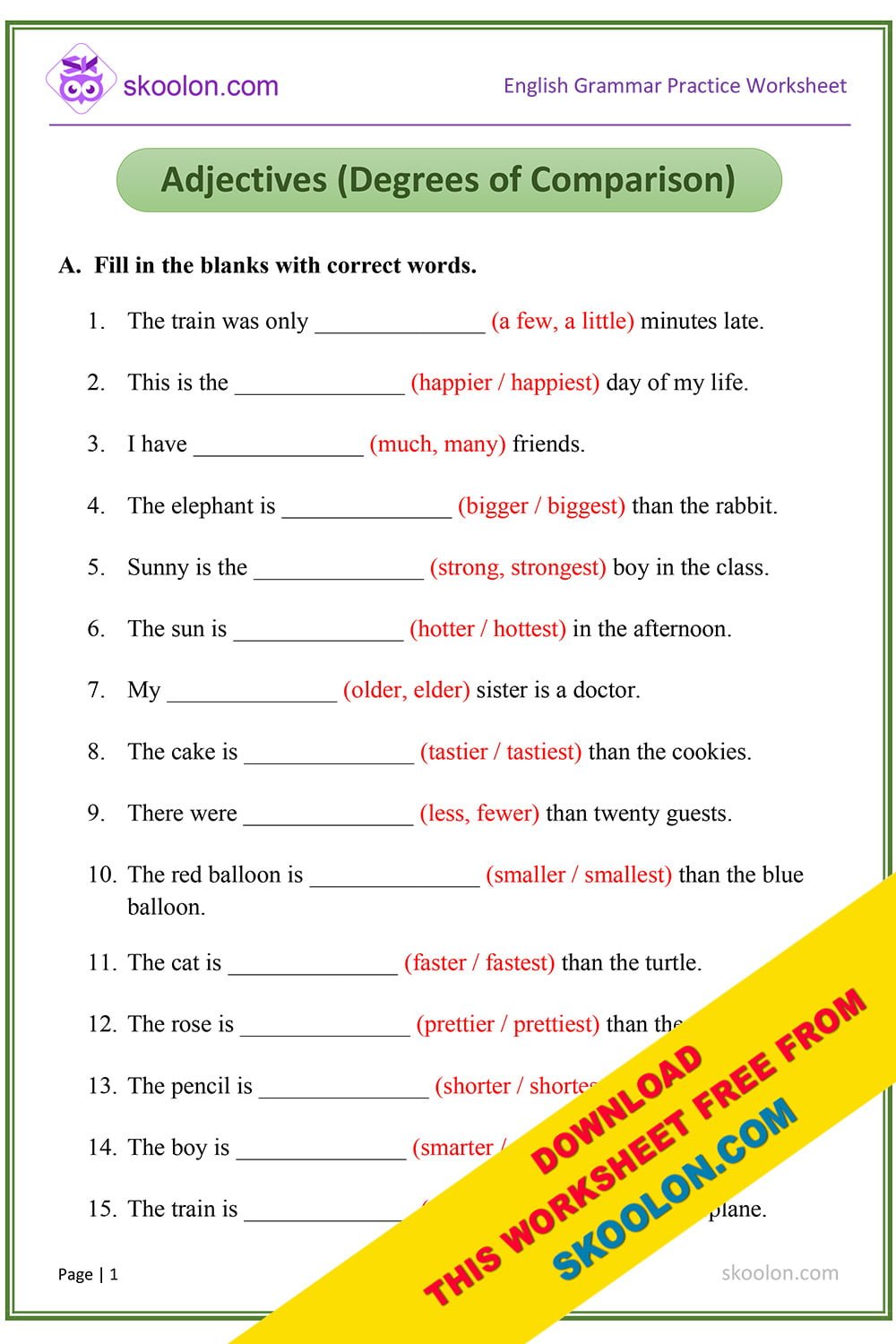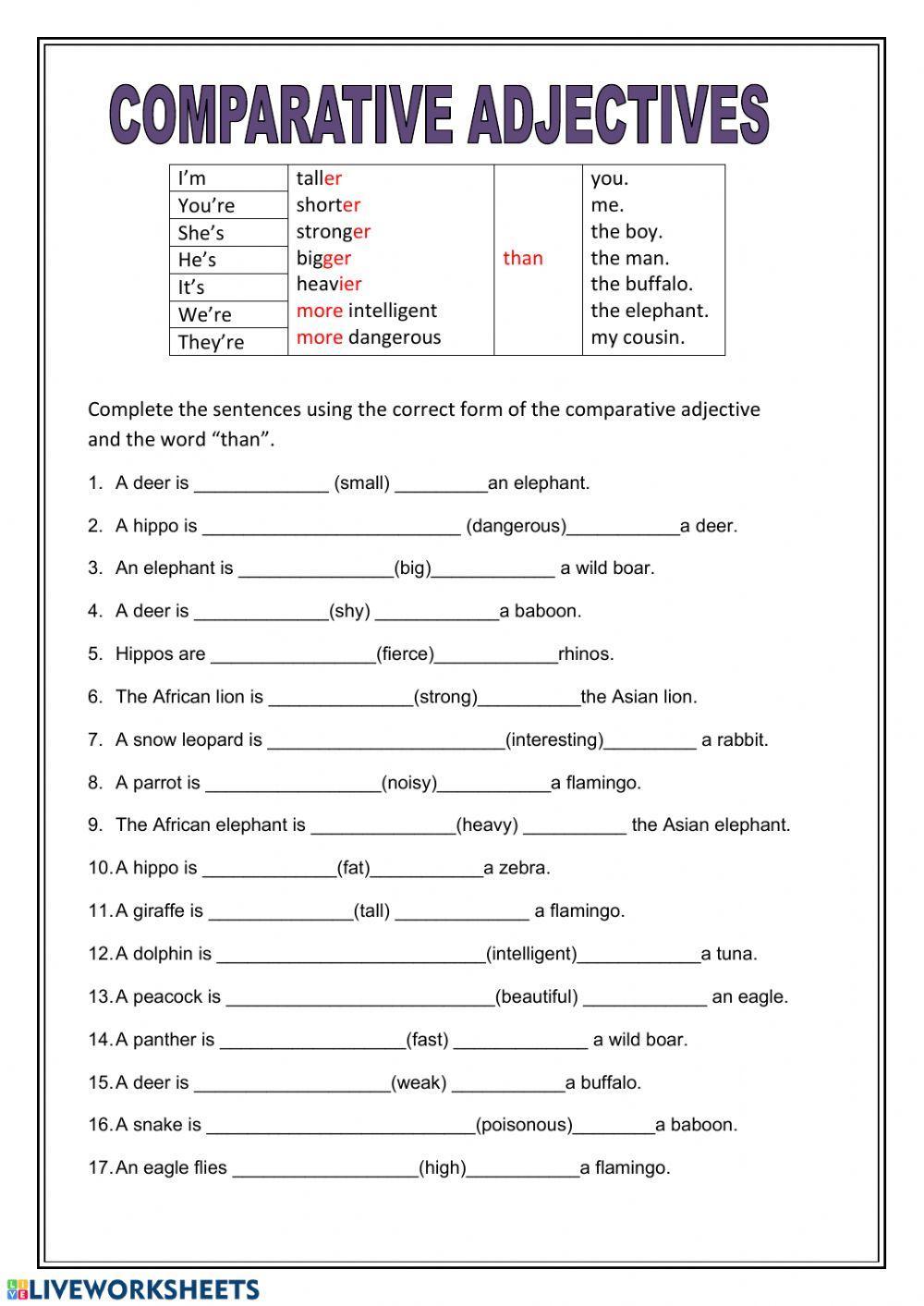
Mastering Degrees of Comparison: The Essential Role of the -er and -est Adjectives Worksheet
Language is a powerful tool for description. It allows us to paint vivid pictures, convey precise meanings, and, crucially, make comparisons. In English, one of the most fundamental ways we achieve this is through the use of comparative and superlative adjectives. These special forms of adjectives, typically ending in -er and -est, respectively, enable us to articulate differences and extremes with clarity. For learners, grasping these concepts is vital for developing fluent and nuanced communication. This comprehensive guide will delve into the intricacies of -er and -est adjectives, explore their rules, common pitfalls, and highlight why a well-designed -er and -est adjectives worksheet is an indispensable resource for effective learning and mastery.
The Foundation: Understanding Adjectives
Before we embark on the journey of comparison, let’s briefly revisit the core function of an adjective. An adjective is a word that describes or modifies a noun or pronoun. It provides more information about the quality, quantity, or characteristic of the person, place, thing, or idea being referred to. For instance, in the phrase "a red car," "red" is the adjective describing the car. Adjectives enrich our sentences, adding detail and precision.

English adjectives typically have three degrees of comparison:

-

Positive Degree: The base form of the adjective, used when no comparison is being made.

- Example: This is a tall building.
-

Comparative Degree: Used to compare two nouns or pronouns.
- Example: This building is taller than that one.


-

Superlative Degree: Used to compare three or more nouns or pronouns, indicating the highest or lowest degree of a quality.
- Example: This is the tallest building in the city.

The transformation from the positive to the comparative (-er) and superlative (-est) degrees is where the journey of mastering these adjectives truly begins.
The Comparative Degree: -er Adjectives
The comparative degree is employed when you are specifically comparing two items, people, or concepts. It signals a direct contrast, indicating which of the two possesses a particular quality to a greater or lesser extent.
Rules for Forming Comparative Adjectives (-er):
-
One-Syllable Adjectives:
- Most one-syllable adjectives form their comparative by adding -er to the end.
- Examples:
- tall → taller
- short → shorter
- old → older
- new → newer
- Examples:
- If the one-syllable adjective ends in a single vowel and a single consonant (CVC pattern), double the final consonant before adding -er.
- Examples:
- big → bigger
- hot → hotter
- thin → thinner
- fat → fatter
- Examples:
- If the one-syllable adjective ends in ‘e’, simply add -r.
- Examples:
- large → larger
- wide → wider
- brave → braver
- Examples:
- Most one-syllable adjectives form their comparative by adding -er to the end.
-
Two-Syllable Adjectives:
- If the two-syllable adjective ends in -y, change the ‘y’ to ‘i’ and add -er.
- Examples:
- happy → happier
- easy → easier
- heavy → heavier
- funny → funnier
- Examples:
- Some two-syllable adjectives that do not end in -y can take either -er or "more." However, it’s generally more common and natural to use "more" for most of them.
- Examples:
- clever → cleverer / more clever (both are acceptable, ‘cleverer’ is less common in modern speech)
- simple → simpler / more simple
- quiet → quieter / more quiet
- Examples:
- If the two-syllable adjective ends in -y, change the ‘y’ to ‘i’ and add -er.
-
Adjectives with Two or More Syllables:
- For most adjectives with two or more syllables (excluding those ending in -y), we use the word "more" before the adjective. We do not add -er.
- Examples:
- beautiful → more beautiful
- expensive → more expensive
- difficult → more difficult
- important → more important
- Examples:
- For most adjectives with two or more syllables (excluding those ending in -y), we use the word "more" before the adjective. We do not add -er.
Common Usage: The comparative adjective is almost always followed by "than" when directly comparing two entities.
- Example: Sarah is taller than her brother.
- Example: This book is more interesting than the last one I read.
The Superlative Degree: -est Adjectives
The superlative degree is used when comparing three or more items, people, or concepts, and you want to highlight the one that possesses a particular quality to the highest or lowest degree within that group. It signifies the extreme.
Rules for Forming Superlative Adjectives (-est):
-
One-Syllable Adjectives:
- Most one-syllable adjectives form their superlative by adding -est to the end.
- Examples:
- tall → tallest
- short → shortest
- old → oldest
- new → newest
- Examples:
- If the one-syllable adjective ends in a single vowel and a single consonant (CVC pattern), double the final consonant before adding -est.
- Examples:
- big → biggest
- hot → hottest
- thin → thinnest
- fat → fattest
- Examples:
- If the one-syllable adjective ends in ‘e’, simply add -st.
- Examples:
- large → largest
- wide → widest
- brave → bravest
- Examples:
- Most one-syllable adjectives form their superlative by adding -est to the end.
-
Two-Syllable Adjectives:
- If the two-syllable adjective ends in -y, change the ‘y’ to ‘i’ and add -est.
- Examples:
- happy → happiest
- easy → easiest
- heavy → heaviest
- funny → funniest
- Examples:
- Similar to the comparative, some two-syllable adjectives not ending in -y can take either -est or "most." Again, "most" is generally more common for clarity.
- Examples:
- clever → cleverest / most clever
- simple → simplest / most simple
- quiet → quietest / most quiet
- Examples:
- If the two-syllable adjective ends in -y, change the ‘y’ to ‘i’ and add -est.
-
Adjectives with Two or More Syllables:
- For most adjectives with two or more syllables (excluding those ending in -y), we use the word "most" before the adjective. We do not add -est.
- Examples:
- beautiful → most beautiful
- expensive → most expensive
- difficult → most difficult
- important → most important
- Examples:
- For most adjectives with two or more syllables (excluding those ending in -y), we use the word "most" before the adjective. We do not add -est.
Common Usage: The superlative adjective is almost always preceded by the definite article "the."
- Example: Mount Everest is the highest mountain in the world.
- Example: She is the most intelligent student in the class.
Irregular Adjectives: Breaking the Rules
As with many aspects of English grammar, there are exceptions to the rules. A handful of common adjectives have irregular comparative and superlative forms that do not follow the -er/-est pattern. These must be memorized:
- Good: better (comparative), best (superlative)
- Bad: worse (comparative), worst (superlative)
- Far: farther/further (comparative), farthest/furthest (superlative)
- (Farther/farthest typically refers to physical distance; further/furthest can refer to physical distance but is also used for abstract advancement or additional quantity.)
- Little: less (comparative), least (superlative)
- Much/Many: more (comparative), most (superlative)
Understanding and consistently applying these rules, including the irregular forms, is key to accurate and effective communication. This is precisely where targeted practice comes into play.
The Indispensable Role of the -er and -est Adjectives Worksheet
For learners of all levels, from beginners grappling with foundational grammar to advanced students refining their precision, the -er and -est adjectives worksheet serves as a cornerstone of effective learning. Why are these worksheets so valuable?
- Structured Practice: Worksheets provide a focused environment for practicing specific grammatical rules without distraction. They break down complex concepts into manageable exercises.
- Repetition and Reinforcement: Mastery comes with repetition. A well-designed worksheet offers multiple opportunities to apply the rules for forming comparative and superlative adjectives, solidifying understanding.
- Immediate Application: Learners move directly from theory to practice, translating their knowledge of rules into actual sentence construction.
- Identification of Gaps: Through exercises, learners (or their instructors) can quickly identify specific areas where understanding is weak, allowing for targeted remediation.
- Variety of Exercise Types: A good -er and -est adjectives worksheet isn’t just about filling in blanks. It can include:
- Transformation exercises: Changing positive adjectives to comparative or superlative forms.
- Sentence completion: Choosing the correct form of the adjective to complete a sentence.
- Error correction: Identifying and fixing mistakes in sentences that misuse comparative or superlative forms.
- Sentence writing: Creating original sentences using given adjectives in their comparative or superlative forms.
- Multiple choice questions: Selecting the best comparative/superlative form from a set of options.
- Comparison tasks: Comparing two or more objects/people/places based on given characteristics.
Crafting an Effective -er and -est Adjectives Worksheet
Whether you are a teacher creating resources or a learner seeking to maximize your study time, consider these elements for an effective -er and -est adjectives worksheet:
- Clear Instructions: Ensure the instructions for each exercise are unambiguous and easy to follow.
- Gradual Difficulty: Start with simpler tasks (e.g., forming the adjectives) and gradually introduce more complex exercises (e.g., using them in context, identifying errors).
- Diverse Examples: Include a wide range of adjectives, covering one-syllable, two-syllable (ending in -y and others), multi-syllable, and irregular forms.
- Contextual Relevance: Whenever possible, use sentences and scenarios that are relatable and engaging for the learner. This makes the practice feel more meaningful.
- Answer Key: An answer key is crucial for self-assessment, allowing learners to check their work and understand where they went wrong.
- Visual Appeal: A well-organized and visually clear layout enhances readability and reduces cognitive load.
Beyond the Worksheet: Integrating Learning
While the -er and -est adjectives worksheet is an invaluable tool, it should be part of a broader learning strategy. To truly master comparative and superlative adjectives, learners should:
- Read Widely: Pay attention to how native speakers use these forms in books, articles, and online content.
- Listen Actively: Notice the comparative and superlative forms in conversations, podcasts, and media.
- Speak and Write: Actively incorporate these adjectives into their own spoken and written English. Practice creating sentences that compare and contrast.
- Engage in Games and Activities: Use flashcards, quizzes, debates, or descriptive games that require the use of comparative and superlative forms. For example, "Which animal is faster?" or "What is the most beautiful place you’ve ever seen?"
Conclusion
The ability to compare and contrast is fundamental to effective communication in any language. In English, mastering the -er and -est forms of adjectives, along with the use of "more" and "most," unlocks a higher level of descriptive power and precision. From describing who is taller to identifying the most interesting movie, these grammatical structures are integral to everyday conversation and academic writing alike.
For learners on their journey to English fluency, a well-structured and comprehensive -er and -est adjectives worksheet is not merely a collection of exercises; it is a vital training ground. It provides the necessary repetition, varied challenges, and immediate feedback required to transform theoretical knowledge into practical, confident application. By embracing both the structured practice of worksheets and the dynamic application of language in real-world contexts, learners can confidently navigate the nuances of comparative and superlative adjectives, enriching their English proficiency one comparison at a time.
